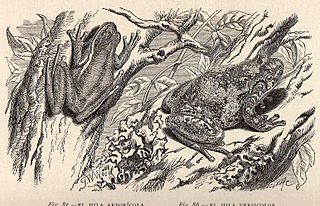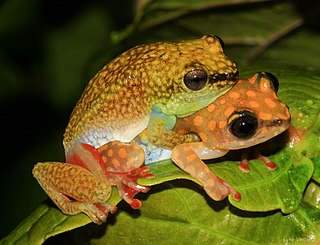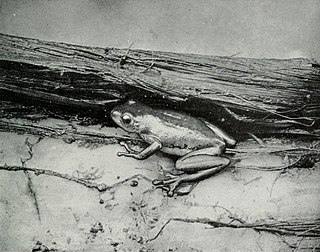
Kassina is a genus of hyperoliid frogs, commonly referred to as running frogs or kassinas. They are found throughout sub-Saharan Africa. They are characterized by preferring a distinctive "walking" with the back legs instead of the more traditional frog-hopping.
"Centrolene" medemi is a species of frog in the family Centrolenidae. The species occurs in the Cordillera Oriental in the Tolima, Caquetá, and Putumayo Departments in Colombia and adjacent Napo in Ecuador. The generic placement of this species within the subfamily Centroleninae is uncertain. The specific name medemi honors Fred Medem, collector of the holotype. Common name Medem giant glass frog has been coined for it.

Nymphargus cochranae is a species of frog in the family Centrolenidae. It is found in the lower Amazonian slopes of the Cordillera Occidental of Ecuador and adjacent Colombia, though the Colombian records require confirmation.

Dryophytes arboricola, commonly known as the arboreal treefrog, is a species of frog in the family Hylidae endemic to the Sierra Madre del Sur in Guerrero state, Mexico.
Beck's tree frog is a species of frogs in the family Pelodryadidae. It is endemic to Papua New Guinea. Its natural habitats are tropical moist montane forests, grasslands and streams. It was first described by the British biologist and herpetologist Arthur Loveridge in 1945 and is named in honour of the American ornithologist and explorer Rollo Beck who led the Whitney South Seas Expedition in the 1920s, collecting bird and other specimens from thousands of islands in the South Pacific.
Osteocephalus fuscifacies is a species of frog in the family Hylidae endemic to Ecuador. It is known from the Napo River drainage at intermediate elevations. The specific name fuscifacies is derived from Latin fuscus (=tan) and facies (=face), in reference to the uniform tan-colored loreal region and the lack of a light subocular spot. Common name Napo slender-legged treefrog has been coined for this species.
Afrixalus uluguruensis is a species of frog in the family Hyperoliidae. Its common name is Uluguru banana frog. It is endemic to the Eastern Arc Mountains of Tanzania and known from the Kipengere Range, Mahenge, Udzungwa Scarp, Rubeho, North Uluguru, Nguru, Ukaguru, and Nguu Mountains.

Hyperolius guttulatus is a species of frog in the family Hyperoliidae. It occurs in West and Middle Africa between Sierra Leone in the west and Gabon in the east/south. Common name dotted reed frog has been coined for this species.

Hyperolius mitchelli is a species of frogs in the family Hyperoliidae. It is found in the area between northeastern Tanzania, Malawi, and central Mozambique.

Hyperolius picturatus is a species of frog in the family Hyperoliidae. It is found in northern and eastern Sierra Leone, southern Guinea, Liberia, Ivory Coast, and Ghana; its range might extend to Togo. Common names coined for this species are Tanzania reed frog and variable montane sedge frog.
Kassina arboricola, sometimes known as the Ivory Coast running frog, is a species of frog in the family Hyperoliidae. It is found in southwestern Ghana and westward to south-central Ivory Coast. It occurs in secondary forests and forest edges, and to very limited extent, degraded former forest. Breeding takes place in both temporary and permanent bodies of water, although it favours large, well-vegetated pools. It is probably negatively impacted by severe deforestation caused by agricultural expansion, logging, and growing human settlements.
Kassina kuvangensis is a species of frog in the family Hyperoliidae. It is found in south-central Angola and northern and western Zambia. Its range probably extends into the southern Democratic Republic of the Congo. It is also known as the Kuvangu running frog, Kuvango running frog, and Kuvangu kassina.
Kassina schioetzi is a species of frogs in the family Hyperoliidae. It is found in Ivory Coast and extreme southeastern Guinea. Its range probably extends into northwestern Ghana.

Leptopelis flavomaculatus is a species of frog in the family Arthroleptidae. It is found in the lowlands eastern and southern Africa, from Mozambique north of the Save River and Zimbabwe to Malawi, eastern Tanzania, and coastal Kenya. Its common names are yellow-spotted tree frog, brown-backed tree frog, brown forest treefrog, and Johnston's treefrog.
Leptopelis modestus is a species of frog in the family Arthroleptidae. Its common names are modest forest treefrog and plain tree frog.
The Tai forest tree frog, Leptopelis occidentalis, is a species of frog in the family Arthroleptidae. It is found in Liberia, southern Ivory Coast, and Ghana. Records from Nigeria are controversial and may refer to other species, possibly Leptopelis boulengeri.
Paracassina kounhiensis is a species of frog in the family Hyperoliidae. It is endemic to Ethiopian highlands east of the Rift Valley. Its natural habitats is montane grassland, less commonly the margins of montane forest. It breeds in marshes and pools. While still locally abundant, it is threatened by habitat loss. A part of its range is within the Bale Mountains National Park.

Phrynobatrachus bequaerti is a species of frog in the family Phrynobatrachidae. It is found in the mountains of north-western Burundi, eastern Democratic Republic of the Congo, and western Rwanda. The specific name bequaerti honours Joseph Charles Bequaert, a Belgian botanist, entomologist, and malacologist and who collected the holotype from Mount Vissoke. Common name Vissoke river frog has been coined for this species.
Kassina jozani is a species of frogs in the family Hyperoliidae. It is endemic to Tanzania and only known from the Jozani Forest on the Unguja Island (Zanzibar).








